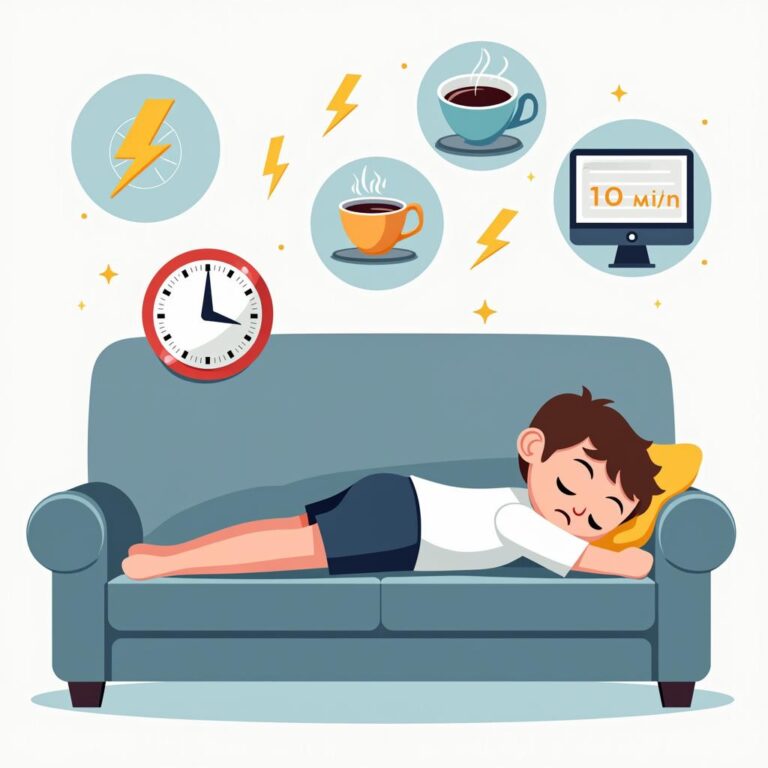In our fast-paced world, where exhaustion is a common theme, more people are discovering the benefits of a power nap. A well-timed and strategically executed power nap can significantly boost your energy levels, improve cognitive performance, and enhance your overall mood. This beginner’s guide will delve into how to power nap for maximum energy, providing insights into the best practices and tips for ensuring your power nap is as effective as possible.
What is a Power Nap?
A power nap is a short sleep that lasts anywhere from 10 to 30 minutes. Unlike longer naps, which can lead to sleep inertia (a feeling of grogginess upon waking), power naps are designed to give your body and mind a quick recharge. The optimal duration for a power nap typically falls between 10 and 20 minutes, allowing you to enter the lighter stages of sleep without diving into the deeper, more restorative stages.
Benefits of Power Napping
Understanding the advantages of power napping can provide the motivation to incorporate it into your daily routine:
- Increased Alertness: A quick nap can refresh your mind, leading to improved alertness and productivity.
- Enhanced Learning and Memory: Napping can enhance your cognitive functioning, making it easier to retain information and learn new skills.
- Improved Mood: A power nap can help in reducing stress and anxiety, offering a lift to your overall emotional well-being.
- Boosted Creativity: A brief mental break can unlock creative thinking, providing you with fresh ideas and solutions.
How to Best Utilize Your Power Nap
To reap the rewards of power napping, follow these practical steps:
1. Find the Right Time
The timing of your power nap is crucial. The best time to nap is typically in the early afternoon, between 1 PM and 3 PM, when energy levels tend to drop. However, listen to your body’s signals and find a window that works best for you.
2. Set Your Duration
As mentioned earlier, aiming for a power nap of 10 to 20 minutes is ideal. If you are new to power napping, start with shorter durations to ease into it. Use an alarm to ensure you don’t oversleep and enter deeper sleep stages.
3. Create a Comfortable Environment
To improve your chances of falling asleep quickly, pick a quiet, dark space to nap. Consider using an eye mask to block light and earplugs or white noise machines to eliminate disruptive sounds. If possible, recline in a comfortable chair or find a cozy spot on a couch or bed.
4. Establish a Pre-Nap Ritual
Designating a pre-nap ritual can signal to your body that it’s time to sleep. This process may include activities like stretching, meditating, or deep breathing exercises. Such practices can facilitate a smoother transition into your power nap.
5. Be Mindful of Your Post-Nap Routine
When your alarm signals the end of your nap, give yourself a moment to awaken gradually. Stretching and taking deep breaths can help you return to a fully alert state. Avoid jumping straight back into work; instead, take a few moments to hydrate and perhaps engage in light activity to re-energize your body.
The Science Behind Power Napping
Research has shown that naps can enhance cognitive performance significantly. A study by NASA found that a 10-minute nap improves memory recall while a 20-minute nap enhanced alertness and cognitive functioning. Even short naps trigger the release of proteins in the brain that help restore mental processes, further reinforcing the idea of using naps as a tool to maintain peak performance.
Common Misconceptions About Power Naps
There are several misconceptions surrounding power napping that may deter people from giving it a try:
- “Napping is for the Lazy”: Power napping is a highly effective performance enhancement technique rather than a sign of laziness.
- “Naps Make You Groggy”: When done correctly, naps shouldn’t lead to grogginess. Keeping naps short and timing them appropriately helps avoid this issue.
- “I Can’t Nap at Work”: Many workplaces are increasingly recognizing the benefits of power naps, implementing designated nap spaces and flexible schedules to accommodate this practice.
Power Napping in Different Cultures
Many cultures around the world have long embraced napping as a beneficial practice. In Spain, the traditional siesta allows people to rest in the afternoon. Similarly, cultures in Latin America, Italy, and even parts of Asia prioritize afternoon rests. Recognizing the advantages of power naps can encourage more individuals to integrate this practice into their daily routine, leading to improved productivity and overall well-being.
Conclusion
Incorporating power naps into your daily routine can significantly enhance your energy levels and overall mental clarity. By understanding the optimal duration, timing, and environment for your naps, as well as debunking common misconceptions, you can establish a rewarding power napping regimen. Start experimenting with power napping today, and unlock the potential for maximum energy and improved productivity!







